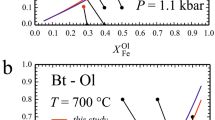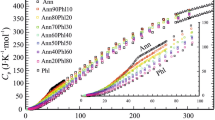Abstract
The reaction-displacement technique was applied to the end-member reaction annite = sanidine + magnetite + H2 in order to determine the activity of the annite component (a Ann) in iron biotites with variable degrees of the Tschermak's substitution ([6]Fe + [4]Si = [6]Al + [4]Al). Based on the simplified relation a Ann = f H 2/foH2 (foH2 = hydrogen fugacity of the end-member reaction at P, T), two types of experiments were performed at 700°C / 2 kbar: Type I used Fe-Al biotites of known starting composition together with sanidine + magnetite + H2O. This assemblage was exposed to various f H 2 conditions (f H 2 < foH2) produced in the pressure vessel either by using different ratios of water/oil as pressure medium (f H 2 in this case was measured by the hydrogen sensor technique), or by the Ni′NiO buffer. The composition of the Fe-Al biotites changed through incorporation or release of the annite component in response to the externally imposed f H 2. By using opposite biotite starting compositions, the equilibrium composition as a function of f H2 was bracketed. For type II, f H 2 in equilibrium with a specific combination of fine-grained Fe-Al biotite (+ sanidine + magnetite + H2O) was measured internally by application of the hydrogen sensor technique. Both type I and type II experiments yield consistent results demonstrating that a fine-grained assemblage of Fe-Al biotite (+ sanidine + magnetite + H2O) is able to act as a sliding-scale buffer. The final chemical composition of the Fe-Al biotite after the experiments was determined by electron microprobe and Mössbauer spectroscopy. The [4]Al and [6]Al in the biotites are coupled according to the Tschermak's substitution. In the tetrahedral sheet 0.1 Al-atoms per formula unit are present in excess to the amount required to balance [6]Al, and all Fe-Al biotites contain 8–10% Fe3+. Therefore, they are not members of the pure annite - siderophyllite join, but have an almost constant amount (15 Mol%) of two additional Fe3+-bearing components (ferri-siderophyllite and a vacancy end-member). The volume - composition relationship obtained does not indicate excess molar volumes of mixing for the annite (Ann) - siderophyllite (Sid) binary. The data are consistent with a molar volume of annite of 15.46 ± 0.02 Jbar–1 and of 15.06 ± 0.02 Jbar–1 for siderophyllite. The experimentally determined activity - composition relation shows that biotites on the join annite - siderophyllite deviate negatively from ideality. A symmetric interaction parameter WAnnSid is sufficient to represent the data within error. This was constrained as: W AnnSid = –29 ± 4 kJmol–1. This is in contradiction to empirical interaction parameters derived from natural assemblages for this binary that predict positive deviation from ideality. Reasons for this discrepancy are discussed.
Similar content being viewed by others
Author information
Authors and Affiliations
Additional information
Received: 20 November 1995 / Accepted: 22 April 1996
Rights and permissions
About this article
Cite this article
Benisek, A., Dachs, E., Redhammer, G. et al. Activity-composition relationship in Tschermak's substituted Fe biotites at 700°C, 2 kbar. Contrib Mineral Petrol 125, 85–99 (1996). https://doi.org/10.1007/s004100050208
Issue Date:
DOI: https://doi.org/10.1007/s004100050208




